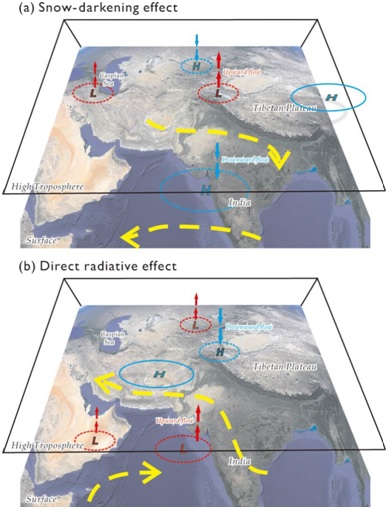Light absorbing aerosols (e.g., dust and black carbon) can darken the snow and reduce the surface albedo when deposited in snow, and they can also absorb the radiation and warm the snow surface, which both accelerate the melt process of snowpack, modify the regional energy budget and affect the climate ("the snow-darkening effect", SDE). Due to the importance in anthropogenic activities, the researches on the SDE are mostly focused on black carbon.
A previous study (Qian et al., 2011) indicates that, the SDE of black carbon reduces the snow cover when deposited on the Tibetan Plateau (TP) and intensifies the thermal source, which promotes the development of Indian summer monsoon. However, the SDE of dust on the Indian monsoon is still not clear. Actually, as a kind of natural aerosol, dust has a significantly larger deposition on the TP than black carbon. More importantly, dust is considered as one of the primary factors controlling climate change during glacial-interglacial stages and its climatic effect should be evaluated in detail.
Recently, Dr. SHI Zhengguo and his colleagues from Institute of Earth Environment, Chinese Academy of Sciences, had evaluated the SDE and direct radiative effect (DRE) of Asian dust on Indian monsoon using Community Atmosphere Model 4. In order to compare with previous studies, the SDE and DRE of black carbon were also considered. The results showed that, the SDE of black carbon could strengthen the thermal source over the TP and intensify the Indian summer monsoon. But for dust, the mechanism was complicated. Although the western TP also became warmer by dust (similar with black carbon), the Indian monsoon during the onset did not become stronger.
Oppositely, the SDE of dust could significantly weaken the Indian monsoon circulation and precipitation. This was because the spatial distributions of dust and black carbon were different. Over the source areas over Central Asia during spring, large dust deposition and snow cover existed. The warming areas induced by dust did not cover the western TP, also extended to Central Asia (near Caspian Sea). The amplified warming areas remarkably modulated the response of atmospheric circulation pattern, with the branch from arid continent over Central Asia strengthened and the other branch from moist Indian Ocean weakened, which finally suppressed the monsoon precipitation over India.
As for the DRE, dust and black carbon both strengthened the Indian summer monsoon. The difference was that black carbon warms surface TP via its absorption and intensifies the monsoon, but dust warmed the Arabian Peninsula and promotes the moisture transport to India. Compared to the previous studies which emphasized the thermal change over the TP, our study appealed the role of temperature change over source areas in modulating the response of Indian monsoon, which indicated that the links between the influence of aerosols on monsoon and atmospheric thermal change over Asia were complicated and needs to be deeply explored in future.
This work had been published in Atmospheric Chemistry and Physics.

Fig.1 Schematic diagrams showing the forcing mechanisms of the direct radiative effect of mineral dust on the Indian monsoon during the onset. The circles and abbreviation in them denote the anomalous pressure centers: high pressure (blue), low pressure (red), near surface (dashed) and high troposphere (solid). The red and blue arrow indicate the upward and downward air flows, respectively, and the yellow ones present the differences in horizontal wind. (Imaged by Shi, et al)
Contact: Contact: Bai Jie, Institute of Earth Environment, Chinese Academy of Sciences, Xi'an, China. Email: baijie@ieecas.cn
 © 2015 Institute of Earth Environment,CAS
© 2015 Institute of Earth Environment,CAS Address:No. 97 Yanxiang Road, Xi'an 710061, Shaanxi, China

 Location :
Location :